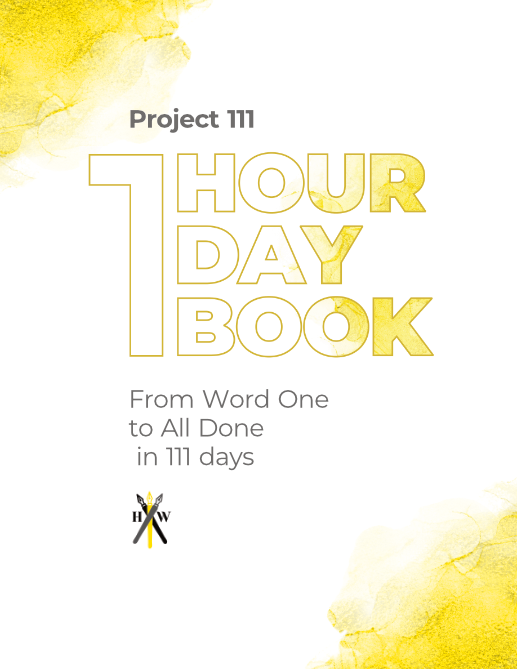Imagine this, you’re writing your story. You have the main character(s), and they’re awesome. You’ve got the setting down, the conflict, the plot as an overview, and now you’ve typed out most of the beginning details.
You have the beginning, and you know where you want to go, but there’s this liminal space between that just doesn’t feel right.
It’s the inciting incident that’s causing you some problems. This is the part of the story where Luke leaves Tatooine, where Batman’s parents die, where Harry follows Hagrid to Hogwarts.
It’s the place of breaking molds, establishing themes, and forcing your character into the unknown. In your own writing, you have come to your own inciting event. You can keep with the status quo of your life before knowing the intimate details of how to write these incidents, or you can seize the call to adventure and write the best inciting incident, wowing your readers and bringing them into the exciting rocket ship of a story you’re cooking up.
Here at Habit Writing, we’ll show you a thing or two about how to plan out and follow through with your inciting incident.
Table of Contents
Let’s Clear the Air

As cliche as starting with a definition is, understanding how we define inciting incident could bring some “insight” into how to “incite” your story’s main conflict.
When speaking of narrative structures, a helpful place to start would be with the author of The Hero With a Thousand Faces, Joseph Campbell. Campbell presented his ideas of narrative flow and story structure by formulating the “Hero’s Journey,” a collection of archetypal events he observed in a multitude of stories.
You have likely come across this method of viewing narratives, and the inciting incident is one of the most important parts. Campbell writes of this “call to adventure” saying:
[The inciting incident]… signifies that destiny has summoned the hero and transferred his spiritual center of gravity from within the pale of his society to a zone unknown.”
This quote is a fancy way of saying that the inciting incident takes the main character from the known, everyday world into an unfamiliar, foreign place.
Campbell writes of a threshold between the known and the unknown worlds. The beginning of the story should take place where the character understands how the world around them works. Most often, authors will establish this known world by letting their main character have a sense of competency.
Forgive the absurd reference, but we see this in the Disney Channel Original movie High School Musical quite clearly. At the beginning of the movie, the characters stick to what they know, for Troy it’s athletic stuff, for Gabriella it’s smart people stuff. They’re in their known world.
In your story, the inciting incident will become even more powerful when you have a strong sense of place and make it seem harder to leave. By doing so, you not only increase the stakes, but you can also offer some efficient characterization early on in the novel (or whatever writing project you’re doing).
Beyond creating the normal world, there are a few moments, key story elements and plot points that will help you form your inciting incident.
Catalyst

The catalyst is something that forces your character into disequilibrium. The catalyst is the event or moment that (often forcibly) invites the protagonist to reckon with the new threshold between the known and unknown worlds.
A catalyst most often appears in the story as an external force. For example, let’s look at Luke Skywalker’s inciting incident. Star Wars: A New Hope was built upon the hero’s journey as a template so we can soundly look at what it does.
While Luke Skywalker may not have been totally satisfied with his life on Tatooine, he didn’t have any imminent plans to leave it. He knew his place in the status quo and lived accordingly. He required an external “force” to set him on his own path to the Jedi.
Not until he encounters Ben Kenobi does he reckon with the notion of leaving Tatooine. Ben presents him with this new knowledge and worldview that fundamentally rewrites the known world. This information carried by Ben constitutes the first instance of a major catalyst for Luke.
The young farm boy is given the choice to trust Ben and listen to him, but the true catalyst–the one that really forces him–comes when Luke returns to his home and finds his aunt and uncle dead.
When writing your own catalyst, don’t be afraid to use external forces to disrupt the status quo. The external, the foreign, the strange most often catalyzes events that lead to the unknown world.

Our 84-page book planner and 111 day writing course.
Debate

The next portion of the inciting incident takes the form of debate. In a sense, this section allows the character to walk the reader through potential consequences for the decision.
This segment should definitely go from external to internal. The character has just experienced something that potentially rocked their worldview. As a reaction to whatever inciting event you’ve chosen, the character will examine their options, internally or symbolically.
By having the character deliberate over their choices, they quickly establish their way of thinking. By writing in their decision-making pattern, the reader can learn the character’s priorities, their fears, their desires, and their motivations (which might be most important).
Let’s say your character’s parents were just kidnapped by some land sharks then dragged back into the depths of the ocean (feel free to write that story). How your character reacts to this absurdly tragic event will characterize them in a way that following the status quo never could.
Are they angry and wanting to seek vengeance? Do they have a visceral fear of abyssal depths? Does sadness overtake them after which a second catalyst must shake them to action?
Similarly, this part of the inciting incident can help you set up flaws and goals, needs and wants. Maybe the protagonist in the previous example has no trouble with fear, they’re ready and willing to save their parents, but they have a broken leg which prevents them from swimming well. The reader will notice right away what the character lacks and the beginning of a character arc forms. These flaws and goals should receive at least some attention here with the “debate” section.
By seeing how the character responds, the reader can also immediately establish their wants. Important in establishing a character’s arc is to clarify the difference between what a character desires to occur and what needs to occur for them to change. The debate should describe what the character wants, and the rest of the story may run counter to that want but give the character what they need.
Decision

This final portion of the inciting incident simply portrays the character reaching their decision and following through with it.
If you’ve done your “debate” correctly, this part of the story should fill the reader with satisfaction. Learning that the story’s protagonist has a new goal and purpose should hook the reader in as they sit back and enjoy the story’s trajectory.
Usually by this point, the reader will know (or think they know) whether or not they’ll enjoy the story or find it worth reading. You need to keep that in mind as you write the decision. By characterizing your protagonist in the other beginning sections, the reader will then determine if they enjoy the promise of the story’s path and/or your main character enough for the novel, short story, or movie to be a good use of their time.
Ideally, all these story elements will build off each other and not detract in any way, but sometimes readers will coast off the inciting incident because it carries enough weight.
But, like all things in writing, balance is key. Just because you have an excellent inciting incident doesn’t mean you’ll entrance your readers. If the character making the decision is so blaringly awful to read, the reader will likely set your story down.
Take the time in this plot point to really dig into the themes and elements of your story. You’ve captured the attention of the reader up to this point, but this crucial moment will sell them on the rest of your work.
Joseph Campbell notes that when the decision is made, “supernatural aid” often accompanies that decision. Part of the satisfaction may come from finalizing their mind and receiving the tools necessary to persevere and carve out their path towards the goal.
BUT(!) shortly following the decision, you should also make it your personal goal to keep that character from achieving what they want. Throw obstacles in their way. Show them that the unknown world is dangerous. Let the conflict start to envelope them.
Doing so strengthens the inciting incident’s weight in the story and should enthrall your reader to continue exploring the ins and outs of the world you’ve made.
Where to Put the Incident
Deciding where to place your inciting incident can be just as tricky as writing it. Not only do you have to make sure the reader is invested enough in your character, you also have to make sure it doesn’t come too early where the reader feels no attachment or too late where the reader gets bored.
There’s no hard and fast rule for when to write the inciting incident in a novel. Movie scripts typically follow a more structured formula and short stories have the inciting event almost immediately on opening.
Novels also run into the issue of genre conventions and length. Huge, weighty fantasy novels often save their inciting incident for later in the story. Detective and thriller novels often begin with the inciting incident.
So where should you write it in?
A good rule to follow is “sooner rather than later”. This moment in the story kicks it into gear and sets off the main plot. The longer you spend in the status quo, the more likely you are to bore your readers (and yourself).
The true joy of reading and writing mostly comes during and after the inciting incident, so why not get to it?
With that in mind, if we were to put a quantifiable location to the inciting incident, usually about 20-30 pages is enough time to establish the character and get them in or through their inciting incident.
You definitely have flexibility with those numbers, but just be aware that if you’re already halfway through your novel and your character(s) are still in the known world living the status quo, you may have a bored reader on your hands.
Things to Consider

Your inciting event is an important moment in the story that should play into other plot points and story elements. No story exists in a vacuum, and the pieces of your narrative should fit together like a well-oiled machine.
Over at Narrative First, they have an article about the inciting incident of Star Wars that has some excellent advice about narrative cohesion:
The Inciting Incident of a story creates the inequity, the Closing Event resolves it.”
“Inequity” here could mean any number of things, but the idea is a clever one. Having a circuitous story can add some real satisfaction to the readers’ experience and help with foreshadowing and solidifying themes.
Thematically mirroring the beginning and the end is great practice for polishing your books and streamlining them. It all starts with the inciting incident and the themes you find there. Often, those themes will be inadvertent and subconscious, but if you keep in mind the act and essentially reverse it at the end, your story should have a cohesive feel.
That doesn’t necessarily mean that when you plan your inciting incident you should also plan the end of your story, but doing so could prove beneficial. Additionally, it may help you better understand what change you want from your character and how you would like to get them there.
Another thing to consider concerning inciting events are side characters and antagonists. Theoretically, every character in the story can have their own inciting event. Why does the fellowship decide to follow Frodo? What happened that made Voldemort so evil?
You don’t need to write every single event that led the characters to where they are, but keeping these things in mind (and having them written down somewhere) will add a depth to your characters and enable you to better understand their motives.
You can take this idea of inciting incidents further in your worldbuilding. If you’re doing a sci-fi/fantasy, think of the history of the planet’s inhabitants. Each faction, race, and group should have inciting incidents that led them to their beliefs and motivations.
Thinking of stories in this way should help you keep excitement in all your characters, locations, history, and whatever else you bring into your work.
In Conclusion
The inciting incident is one of the most important parts of a story’s beginning. Perhaps more so than the first chapter, you’re giving your audience a preview of what to expect for the rest of the story.
When planning the inciting incident, be sure to remember the catalyst that will force the character to a decision, the character’s debate where they explore their options and consequences, and finally the decision itself.
When you have these elements in your inciting incident, you’ll be able to have a dynamite beginning to your tale and excite the reader for the rest of your plans.
Considering different aspects of your story in the light of inciting incidents can be a really useful tool for all your worldbuilding.
For more helpful tips, tools, and writing habits, stick with us here at Habit Writing.
gavinwride
Gavin is a fantasy author, short story enthusiast, and nature lover. When he’s not reading, writing, or exploring the outdoors, he is likely playing games. His board game collection is probably too big for someone living in a small apartment, and he has enough yet-to-be-played video games to fill a lifetime. His favorite book is "The Name of the Wind". His favorite author is Edward Abbey. His favorite game is "Dark Souls III", and he’d be more than happy to spend the day talking about lore, bosses, and game mechanics.
Our 84-page book planner and 111 day writing course.
